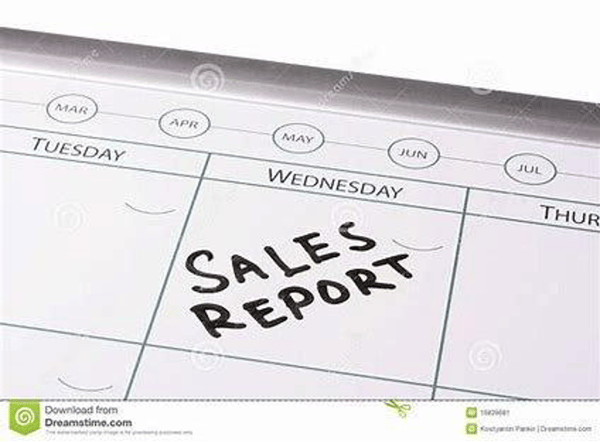That’s not to say we encourage an environment of covert behaviour where getting access to information is akin to the plot of a spy novel. A sales report shared responsibly has the power to ignite a business, motivate a sales executive in need of a confidence boost or shine a light on fractures in strategy.
Right now, write down how often you run a sales report. Then, when and who you share it with. If you’re generating this once a day, that’s probably too much. Once a quarter? Probably not enough. And if you’re heading up a sales team and keeping the insight to yourself that’s also not always helpful. But sharing every line of data, whether it has value or not? Yep, not helpful.
You could argue that the introductory statement was also not helpful. Lots of “what not to do”, and not much on offer in the way of advice. So, let’s rewind and start again.
Sales reports – extremely important in terms of the metrics that are up for analysis; what’s being reported, frequency of publication, and who gets to see them. Not only is this your window into what is being sold, in which territory, and how much product is shifting, but this is how you measure how an individual or team is performing and where any new deals are in the sales pipeline.
You know you want to know more, you want to get sales reporting right every time, so here’s our smart guide to sales reporting.

You know you want to know more, you want to get sales reporting right every time, so here’s our smart guide to sales reporting.
1. Sales Reports Start with a First-class CRM Platform
Before you consider the frequency and readership of any given sales report, be confident that your Customer Relationship Management (CRM) tool is up to the task. That means if you haven’t done so already, moving away from multiple Excel spreadsheets and disparate reporting tools and embracing one sales performance management (SPM) system that not only contains every bit of customer information but reliably captures deals in progress and closed deals, while allowing sales executives to post queries and add their sales. We’d also strongly recommend that you opt for an integrated system with the option to add customized fields. If for example, your main KPI for the next business year is opening up to a new market, make sure you can see territory-related dashboards and sales reports, and not just performance information about individuals. With a compatible CRM that earns its place on the team, you’ll have no trouble rolling out the correct sales report template.
We began by dismissing the concept of sales reports overload, but it’s worthwhile understanding why there really is such a thing as “too much information”. While anxious minds and restless fingers may find it difficult to resist the urge to run a sales report every day – especially if you have the SPM platform to do so – the negative implications for this are simple:
- Difficult to detect trends and changing circumstances when dipping in too regularly
- Can create “performance anxiety” for your team and individuals, leading to stress rather than motivation
- May obscure other contributing metrics and factors and cause you to lose context
- If you’re the person running the reports, you could be spending too much time on this rather than other critical parts of the role.
It’s easier to gauge when you should run a particular sales report by having a deeper understanding of the relevance and value at any given point.
- Is it time-critical?
- Can it help to improve sales?
- Will individual or team performance be enhanced by running it?
- Is there a chance it will be needed for presenting to stakeholders?
- Does a product launch or product discontinuation hinge on the data?
If the answer is “yes” to at least one of the above criteria, that’s more than enough justification to run that sales report.
Some business strategists are committed to the “25% rule”. That is, the most amount of time in a week they’ll spend on generating reports. That could be interpreted as a little bit too rigid and prescriptive. If we were thinking about this year’s fluctuating economic landscape, for example, that wouldn’t fall within any set of usual rules and conventions. With so much disruption to the supply chain and demand, sales reporting would certainly exceed that rule.
3. When to Share that Sales Report
We can sum this up easily; if it’s relevant to the development, performance, and well-being of a person, team, or even the whole business, share it out. Conversely, does a mid-weight software developer based in the IT building in Bangalore need to know
to information is akin to the plot of a spy novel. A sales report shared responsibly has the power to ignite a business, motivate a sales executive in need of a confidence boost or shine a light on fractures in strategy.
the sales team pushing spelt flour to bakeries in Saskatchewan performed in April-June?

To share or not to share
That’s not to say we encourage an environment of covert behavior where getting access
In Summary: Your Single Source of Truth
If you’re fully utilizing your CRM, there will be many occasions and stakeholders that require a fully customized and specific report in a matter of moments. There are also reports that gain value when generated at regular intervals. If you really know your products and team, the thought processes, and decisions behind whether a report should be fortnightly or monthly will come naturally.
And of course, a worthwhile sales report is only as good as the information that goes into it. Although far less error-prone than the old spreadsheet method, a CRM or SPM will only be your most valuable player if the sources of data and input are correct.
Happy reporting.
There’s a wealth of SPM tools and resources available from Varicent. Visit www.varicent.com today and discover how we can help your sales force prosper.




